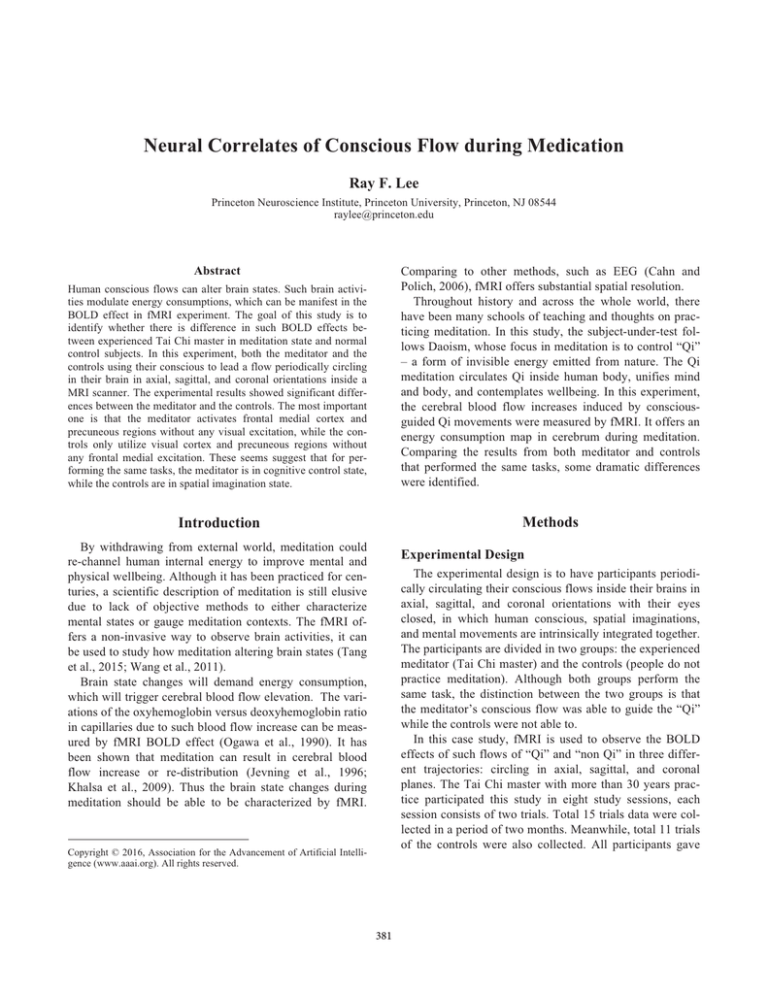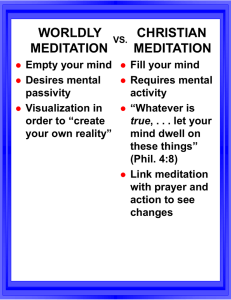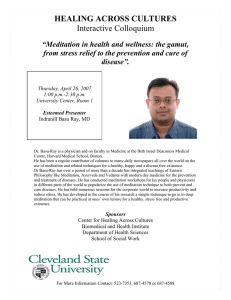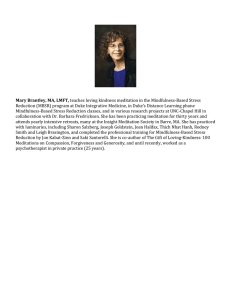
Neural Correlates of Conscious Flow during Medication
Ray F. Lee
Princeton Neuroscience Institute, Princeton University, Princeton, NJ 08544
raylee@princeton.edu
Human conscious flows can alter brain states. Such brain activities modulate energy consumptions, which can be manifest in the
BOLD effect in fMRI experiment. The goal of this study is to
identify whether there is difference in such BOLD effects between experienced Tai Chi master in meditation state and normal
control subjects. In this experiment, both the meditator and the
controls using their conscious to lead a flow periodically circling
in their brain in axial, sagittal, and coronal orientations inside a
MRI scanner. The experimental results showed significant differences between the meditator and the controls. The most important
one is that the meditator activates frontal medial cortex and
precuneous regions without any visual excitation, while the controls only utilize visual cortex and precuneous regions without
any frontal medial excitation. These seems suggest that for performing the same tasks, the meditator is in cognitive control state,
while the controls are in spatial imagination state.
Comparing to other methods, such as EEG (Cahn and
Polich, 2006), fMRI offers substantial spatial resolution.
Throughout history and across the whole world, there
have been many schools of teaching and thoughts on practicing meditation. In this study, the subject-under-test follows Daoism, whose focus in meditation is to control “Qi”
– a form of invisible energy emitted from nature. The Qi
meditation circulates Qi inside human body, unifies mind
and body, and contemplates wellbeing. In this experiment,
the cerebral blood flow increases induced by consciousguided Qi movements were measured by fMRI. It offers an
energy consumption map in cerebrum during meditation.
Comparing the results from both meditator and controls
that performed the same tasks, some dramatic differences
were identified.
Introduction
Methods
Abstract
By withdrawing from external world, meditation could
re-channel human internal energy to improve mental and
physical wellbeing. Although it has been practiced for centuries, a scientific description of meditation is still elusive
due to lack of objective methods to either characterize
mental states or gauge meditation contexts. The fMRI offers a non-invasive way to observe brain activities, it can
be used to study how meditation altering brain states (Tang
et al., 2015; Wang et al., 2011).
Brain state changes will demand energy consumption,
which will trigger cerebral blood flow elevation. The variations of the oxyhemoglobin versus deoxyhemoglobin ratio
in capillaries due to such blood flow increase can be measured by fMRI BOLD effect (Ogawa et al., 1990). It has
been shown that meditation can result in cerebral blood
flow increase or re-distribution (Jevning et al., 1996;
Khalsa et al., 2009). Thus the brain state changes during
meditation should be able to be characterized by fMRI.
Experimental Design
The experimental design is to have participants periodically circulating their conscious flows inside their brains in
axial, sagittal, and coronal orientations with their eyes
closed, in which human conscious, spatial imaginations,
and mental movements are intrinsically integrated together.
The participants are divided in two groups: the experienced
meditator (Tai Chi master) and the controls (people do not
practice meditation). Although both groups perform the
same task, the distinction between the two groups is that
the meditator’s conscious flow was able to guide the “Qi”
while the controls were not able to.
In this case study, fMRI is used to observe the BOLD
effects of such flows of “Qi” and “non Qi” in three different trajectories: circling in axial, sagittal, and coronal
planes. The Tai Chi master with more than 30 years practice participated this study in eight study sessions, each
session consists of two trials. Total 15 trials data were collected in a period of two months. Meanwhile, total 11 trials
of the controls were also collected. All participants gave
Copyright © 2016, Association for the Advancement of Artificial Intelligence (www.aaai.org). All rights reserved.
381
and the group average of the 11 trials of the controls’ data
were calculated separately, and yielded the baseline BOLD
responses for both meditator and controls respectively.
To extract the common responses to the mental circling
tasks from both meditator and the controls, three regressors
were applied in the GLM. They are set to ON during axial,
sagittal, and coronal circling period respectively, and set to
OFF during the rest of the period respectively as well. The
averaging process took two steps: first, for each trial’s data, all three regressions were averaged to form a “3dimension (3D)” response; second, the “3D” responses of
all 26 trials (including meditator’s and controls’ data) were
averaged. The result was an estimation of how general
people (meditator and non-meditator alike) responded to
the mental circling tasks without consideration of the “Qi”
element.
Finally, to identify the different BOLD responses between meditation and no meditation, the GLM applied the
three regressors for the three orientations, as well as the 3D
average, to the meditation and control groups separately.
The group average of the meditator’s 15 trials of data
yielded average BOLD responses to axial, sagittal, coronal,
and 3D mental circling respectively during meditation.
Whereas the group average of the controls’ 11 trials of data
yield average BOLD responses to axial, sagittal, coronal,
and 3D mental circling respectively without meditation.
Most importantly, the mixed effects of the unpaired t-test
comparison between meditator’s 15 trials and controls’ 11
trials demonstrated the significant differences between
having “Qi” and having “no-Qi” in the conscious-guided
mental circling.
informed and written consent based on the approval of the
institutional review board in the Princeton University.
Data acquisitions
The fMRI experiment is conducted with a block design.
There are five blocks in one period: relaxing, fixating on
most frontal end of brain, circling the conscious flows in
axial, sagittal, and coronal orientations. There are total five
periods in each trial. Given that one whole brain volume
sampling time is 2s, each block has 10 sampling volumes
(20s), each period has 50 volumes (100s), and each trial
has 250 volumes (8min 33second). All participants had
their eyes closed during all scan sessions.
The experiment was conducted on a Siemens 3T MRI
scanner, MAGNETON Prisma (Erlangen, Germany), with
64-ch head/neck coil. The fMRI data acquisition sequence
is EPI, TR 2s, TE 30s, voxel size 2x2x3mm3, field-of-view
192x192mm2, frequency and phase read-out resolutions
96x96, slice thickness 3mm, slice number 32, slice distance factor 20%, iPAT factor 3, and read-out bandwidth
1064Hz/pixel. Besides functional data, an anatomical data
was acquired with MPRAGE sequence for brain registration. A field map was also acquired with gradient echo
sequence for static magnetic field inhomogeneity correction.
Data post-processing
The BOLD responses for the four tasks (1. focusing, 2.
axial, 3. sagittal, and 4. coronal circling) were calculated
by group analysis of general-linear-model (GLM) regression. The comparisons between the meditator and the control groups were estimated by paired t-test comparison.
Both were implemented by the software package FSL (Oxford University, UK) (Jezzard et al., 2001).
In the preprocessing, all functional data sets from both
meditator and controls were put through motion correction,
slice time correction, and brain extraction, as well as spatial smoothing with HMFW 5mm and temporal high pass
filtering with a cut-off period of 100s. All anatomical and
field mapping data sets were also put through bias field
correction and brain extraction. All the functional data sets
were first registered to their corresponding anatomical data
sets, and then registered to the standard MNI152 template
(Mazziotta et al., 1995) for both group analysis and atlas
labeling. The cerebral parcellation and labeling were based
on the built-in Harvard-Oxford Cortical and Subcortical
Structural Atlas (Desikan et al., 2006).
To get the baseline, the GLM’s regressor is set to ON
during the focusing block, and set to OFF during the relaxing and the three circling blocks. For both meditator and
controls, their brain’s spatial imagination was a singular
point, and no mental movement was involved in this situation. The group average of the 15 trials of meditator’s data
Results
Baseline
Before investigating BOLD effects of conscious-guided
mental circling, some baseline data were acquired for each
trial, in which participants set their brain to focus on a
point at the front end of their brain. In this case, both
spatial and mobile imaginations were reduced into a
singular point. Even for such degenerated case, the brain
states in meditation and non-meditation are quite different,
as shown in Figure 1. Figure 1A suggests that meditator
was able to channel the energy directly to the focal point
without recruiting any other brain system. Whereas Figure
1B suggests that imaginations of focusing on a frontal
point by the controls do not directly channel the energy to
that physical point, in stead they mostly recruit visual and
sensorimotor cortices to construct such imagination. Note
that a slight activation on left lateral frontal cortex in both
A and B are the response of verbal commands during the
test.
382
Figure 2. The group average BOLD effect for all three orientations mental circling tasks from both meditation and nonmeditation groups. (Z-score>4.9, p-value<0.01)
Tab .1
max
X
max
Y
max
Z
cog
X
cog
Y
cog
Z
Frontal lobe:
218
F1
33
64
60
31.9
61.5
64.6
207
56
60
60
57.1
60.5
66.7
225
29
63
60
29.3
62.8
65.2
197
58
61
59
60.8
61.9
65.3
109
21
67
53
20.3
66.8
57.3
221
17
72
35
18.4
69.8
44.6
Sensorimotor & visual cortex:
460
27
55
PRG
57
28.9
58.5
65.1
Voxels
F2
Figure 1. The group average BOLD responses when the
conscious focus on a singular point in front end of brains by
meditator in meditation state (A), and by controls in nonmeditation state (B). (Z-score>2.3, p-value<0.05)
F3o
Common responses to the tasks
Given that both the meditator and the controls responded
the same mental circling requests, they shared some
common brain states, which indicated that they were
dealing with the same task at certain level. Such common
responses for all three orientations mental circling tasks
from both meditation and non-meditation groups are
shown in Figure 2, and labeled in Table 1. Notice that a
symmetric and stable pattern is statistically highly
significant (Z>4.9, p<0.01)) in Figure 2 and is highlighted
in Table 1, which consists of bilateral precentral gyrus
(PRG, primary motor cortex), postcentral gyrus (POG,
primary somatosensory cortex), superior lateral occipital
gyrus (LOs, extrastriate visual cortex), as well as medial
juxtapositional lobule (SMC, supplementary motor cortex).
This clearly indicates that the mental circling tasks recruit
sensory, motor, and extrastrate visual cortices in both
meditation and non-meditation cases. Note that the midline
brain, such as frontal medial cortex (FMC) and precuneous
(PCN) and cingulate (CG), are largely missing in the
common responses.
460
15
68
43
18.5
65.6
53.6
326
58
58
59
59.8
59
65.7
SMC
344
46
63
61
45.1
60.8
67.5
POG
622
13
55
49
19.8
51.2
56.2
59
61
44
55
63.6
45.9
56.1
336
36
26
62
35.6
30.3
65.6
218
54
29
60
53.9
29.4
65
Parietal lobe:
392
SPL
28
39
55
26.3
42.3
61.7
SGa
444
13
55
49
18.8
50.4
55.9
SGp
216
18
45
49
24.1
43.7
58.2
LOs
Difference in meditation and non-meditation state
For each of the three mental circling tasks (axial,
sagittal, coronal circling), its group averages and group ttest comparison between meditation and control group are
shown in Figure 3, 4, and 5 respectively.
383
Figure 4 The BOLD response to sagittal circling for meditation
(A), control (B), A-B (C), B-A (D). ( Z>2.3, p<0.05)
Figure 3 The BOLD response to axial circling for meditation
(A), control (B), A-B (C), and B-A (D). ( Z>2.3, p<0.05)
384
The detailed discussion on the differences between the
three orientations may be beyond the scope of this paper,
since the focus here is to compare brain states in
meditation and control. Thus, the comparison between
meditation and control group for all three orientations
together (3D) are given in Figure 6. The detailed
comparisons for “mediation > control” and “control >
meditation” are labeled in Table 2 and Table 3
respectively.
Figure 6 The t-test comparison for all three-orientation circling:
(A) meditation–control, (B) control-meditation. ( Z>2.3, p<0.05)
Apparently the meditator and the controls adapted
different approaches to handle the mental circling tasks. As
shown in Figure 6A and Table 2, the brain states in
meditation showed dominant activations on frontal medial
cortex, precuneous, anterior and posterior cingulate, which
is a typical pattern for cognitive control. Whereas in Figure
6B and Table 3, the brain state of the controls showed most
activations on almost entire visual cortex and precuneous,
which seems to be the pattern of visual imagination, given
that participants were closing their eyes during scans. Such
mutual exclusive results on frontal medial cortex and
occipital lobe seem to experimentally confirm a hypothesis
that that the meditator was using his conscious to guide the
Figure 5 The BOLD response to coronal circling for meditation
(A), control (B), A-B (C), B-A (D). ( Z>2.3, p<0.05)
385
flows of “Qi”, whereas the controls were imagining the
visual trajectories.
Acknowledgement
The author greatly appreciates the Tai Chi master Joe
Zhou for participating the experiments, and the discussions
on Taoism. The author would like to thank Nick DePinto
and Weiming Dai for their help on collecting data.
Tab. 2
max
X
max
Y
max
Z
cog
X
cog
Y
cog
Z
Medial anterior:
574
FMC
44
82
24
44.7
87.6
30.5
References
995
46
89
26
46.6
92
34
480
51
97
47
51.3
87.9
55.1
261
38
90
46
37.4
87
53.5
Cga
405
42
80
31
44.7
83.5
39.1
PAC
1160
42
81
29
45.2
86.5
41
47
32
40
46.7
33.4
49.7
48
36
40
47.4
38
50.2
71
35
49
71.7
34.9
53.9
267
12
52
45
15.8
51.4
50.9
243
78
48
47
73.8
49.9
53.3
SGp
157
73
35
49
73.6
38.2
53.4
(SPL
277
59
41
56
59.9
39.1
63.3
Cahn, B.R., Polich, J., 2006. Meditation states and traits: EEG,
ERP, and neuroimaging studies. Psychological bulletin 132, 180211.
Desikan, R.S., Segonne, F., Fischl, B., Quinn, B.T., Dickerson,
B.C., Blacker, D., Buckner, R.L., Dale, A.M., Maguire, R.P.,
Hyman, B.T., Albert, M.S., Killiany, R.J., 2006. An automated
labeling system for subdividing the human cerebral cortex on
MRI scans into gyral based regions of interest. Neuroimage 31,
968-980.
Jevning, R., Anand, R., Biedebach, M., Fernando, G., 1996.
Effects on regional cerebral blood flow of transcendental
meditation. Physiology & behavior 59, 399-402.
Jezzard, P., Matthews, P., Smith, S., 2001. Functional MRI: an
introduction to methods. Oxford University Press, Oxford, UK.
Khalsa, D.S., Amen, D., Hanks, C., Money, N., Newberg, A.,
2009. Cerebral blood flow changes during chanting meditation.
Nuclear medicine communications 30, 956-961.
Mazziotta, J.C., Toga, A.W., Evans, A., Fox, P., Lancaster, J.,
1995. A Probabilistic Atlas of the Human Brain - Theory and
Rationale for Its Development. Neuroimage 2, 89-101.
Ogawa, S., Lee, T.M., Kay, A.R., Tank, D.W., 1990. Brain
magnetic resonance imaging with contrast dependent on blood
oxygenation. Proceedings of the National Academy of Sciences
of the United States of America 87, 9868-9872.
Tang, Y.Y., Holzel, B.K., Posner, M.I., 2015. The neuroscience
of mindfulness meditation. Nature reviews. Neuroscience 16,
213-225.
Urgesi, C., Aglioti, S.M., Skrap, M., Fabbro, F., 2010. The
spiritual brain: selective cortical lesions modulate human selftranscendence. Neuron 65, 309-319.
Wang, D.J., Rao, H., Korczykowski, M., Wintering, N., Pluta, J.,
Khalsa, D.S., Newberg, A.B., 2011. Cerebral blood flow changes
associated with different meditation practices and perceived depth
of meditation. Psychiatry research 191, 60-67.
Voxel
FP
Medial posterior:
422
PCN
260
CGp
Lateral posterior:
210
AG
Sga
T. 3
Voxel
max
X
Medial posterior:
454
38
PCN
CGp
max
Y
max
Z
cog
X
cog
Y
cog
Z
43
55
39.4
39.1
61.4
256
51
43
56
49.7
40.8
62.3
138
38
44
54
39
44.6
57.4
91
51
45
54
50.6
44.5
57.1
1974
60
19
39
59.2
23.4
52.5
1258
29
20
39
28.9
23.2
48.9
368
66
32
32
64.4
25
39.7
Occipital
lobe:
Los
Loi
183
29
20
38
25.5
24.9
42.2
Cli
264
46
22
38
44.7
23.2
42.1
CLs
262
46
20
39
45.1
22.2
43.2
CNL
531
44
19
41
46.8
22
48.5
115
36
26
45
37.8
23.8
52.1
1112
47
14
36
45.9
17.6
48.1
OP
386




